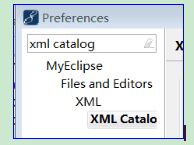框架 day36 Spring3 入门,DI依赖注入,装配bean基于xml/注解, 整合Junit4,配置约束自动提示
1 什么是spring
1.1官网
spring.io
1.2介绍
Spring的核心是控制反转(IoC)和面向切面(AOP)。
IoC(Inverse of Control 反转控制)
AOP(Aspect Oriented Programming 面向切面编程为内核)
简单来说,Spring是一个分层的JavaSE/EE full-stack(一站式) 轻量级开源框架。
*轻量级:依赖其他内容较小,使用资源消耗也少。对比:EJB 重量级
*分层:经典三层体系架构,spring 提供解决方案
>web:struts、spring mvc
>service:spring(事务管理、性能监控、日志记录等)
>dao:hibernate、mybatis、JdbcTemplate、(spring data jpa) 等
1.4Spring优点
1.5体系结构
核心组件:beans、core、context、expression
1.6回顾
2 第一个实例
2.1 IoC 控制反转
*Inversion of control 控制反转,让spring创建对象实例。将创建对象实例的权利反转给spring。
对比:之前是自己new(创建),之后将由spring创建。
2.2开发步骤
*导入jar包
*spring 核心配置文件
*使用api 获得对象实例
2.3导入jar包
*版本:3.2.0
*依赖包:3.0.2
3.0.2 之后spring不再提供依赖包,但提供maven 管理依赖jar包。
*导入
2.4编写核心配置文件
*位置:任意位置,建议:src
*名称:名称任意,建议:applicationContext.xml
*内容:使用schema约束
约束内容:
参考:spring-framework-3.2.0.RELEASE\docs\spring-framework-reference\html\xsd-config.html
2.5dao编写
public class UserDaoImpl implements UserDao {
@Override
public void save() {
System.out.println("a_hello userdao save");
}
}
2.6测试
@Test
public void demo01(){
String xmlPath = "com/itheima/a_hello/beans.xml";
ApplicationContext applicationContext = new ClassPathXmlApplicationContext(xmlPath);
UserDao userDao = (UserDao)applicationContext.getBean("userDao");
userDao.save();
}3 DI 依赖注入
*依赖:一个类中使用了另一个类,我们称为两个类存在依赖关系。
例如:service中使用dao
is a , 是一个,继承(父子类)
has a ,有一个,依赖
DI:Dependency Injection ,从spring获得service实现类(ioc),spring自动(动态的)将dao的实现类注入给service
*service 提供setter方法
public class BookServiceImpl implements BookService {
//private BookDao bookDao = new BookDaoImpl();
private BookDao bookDao;
public void setBookDao(BookDao bookDao) {
this.bookDao = bookDao;
}
public void addBook(){
bookDao.save();
}
}*service配置
4 BeanFactory 和 ApplicationContext 使用
*BeanFactory 采用延迟加载,当第一次调用 getBean方法时初始化
AppliCationContext在加载完成配置文件之后就进行初始化。
*ClassPathXMLApplicationContext 加载的src下面的xml配置文件
new ClassPathXmlApplicationContext(String) 加载一个配置文件
new ClassPathXmlApplicationContext(String...) 加载多个配置文件
例如:web项目 WebRoot/WEB-INF/classes/...
*FileSystemXMLApplicationContext 加载 指定位置的xml配置文件。
例如:web项目 WebRoot/WEB-INF/.... (ServletContext.getRealPath())
5 配置约束自动提示
*步骤一:将Scheme xsd文档拷贝容易获取的目录
位置:spring-framework-3.2.0.RELEASE\schema\beans\spring-beans-3.2.xsd
*步骤二:从xml配置文件中,获取xsd文档位置
例如:http://www.springframework.org/schema/beans/spring-beans.xsd
*步骤三: window/preferences/ 搜索 “xml catalog”
*步骤四:选择用户自定义,点击添加
*步骤五:添加约束提示
注意:如果xml没有提示,关闭xml重写打
6 装配Bean 基于xml
6.1bean 三种实例化方式
1. 使用默认构造实例化(默认无参)
2. 静态工厂(简单工厂模式),与其他项目或框架整合
public class PersonServiceFactory {
public static PersonService createPersonService(){
return new PersonServiceImpl();
}
}
3. 实例工厂(工厂方法模式),使用工厂之间,必须创建工厂。
public class PersonServiceFactory {
public PersonService createPersonService(){
return new PersonServiceImpl();
}
}
6.2bean 种类
*分类:普通bean、工厂bean
*普通Bean:之前使用的所有bean,一般很常用。例如:service、dao
*工厂Bean:spring 提供接口 FactoryBean
FactoryBean,一个特殊Bean,具有Factory工厂,用于生产特定的Bean的一种bean。
例如:ProxyFactoryBean 用于生产代理对象的一个bean
Object obj = new ....FactoryBean();
if(obj instanceof FactoryBean){
FactoryBean factroyBean = (...)obj;
return factroyBean.getObject();
}
return obj; 对比:BeanFactory,用于生产任意bean的工厂。
6.3id和name属性
id 可以自动提示,要求名称不能重复
name 如果没有配置id,name也可以使用。特点:可以编写多个名称,使用逗号分隔
例如:name="n1,n2,n3"
6.4bean作用域
*
*spring 默认情况下创建的bean都是单例的。
*取值:
singleton: 单例,默认值
prototype:多例。例如:struts 与 spring整合时,action必须配置多例。
request:一次请求
session:一次会话
globalsession:集群一次会话。
*要求掌握:singleton、prototype
6.5生命周期(了解)
public class ReplyDao implements BeanNameAware ,ApplicationContextAware ,InitializingBean,DisposableBean{
public ReplyDao() {
System.out.println("1. 初始化");
}
private String username;
public void setUsername(String username) {
System.out.println("2. setter 属性注入");
this.username = username;
}
@Override
public void setBeanName(String beanName) {
System.out.println("3 获得配置bean名称:"+beanName +",必须实现接口:BeanNameAware");
}
@Override
public void setApplicationContext(ApplicationContext applicationContext)
throws BeansException {
System.out.println("4 . 获得spring容器,相当于TestApp new ClassPath... , 必须实现接口:ApplicationContextAware");
System.out.println("---" + applicationContext);
System.out.println("--- 也可以实现接口:BeanFactoryAware");
}
// 5 MyBeanPostProcessor postProcessBeforeInitialization
@Override
public void afterPropertiesSet() throws Exception {
System.out.println("6.初始化前属性设置");
}
//7 初始化 (掌握)
public void replyInit(){
System.out.println("7. 初始化方法,需要在xml配置 ");
}
// 8 MyBeanPostProcessor postProcessAfterInitialization
public void save() {
System.out.println("9. save 方法");
}
@Override
public void destroy() throws Exception {
System.out.println("10. 销毁,必须实现接口:DisposableBean");
}
// 掌握
public void replyDestory(){
System.out.println("11. 销毁,需要配置,");
}
} 要求:初始化和销毁、后处理bean
初始化个销毁
*需要在
*注意:销毁方法要求 1.必须是单例的 2.必须关闭容器
@Test
public void demo01(){
String xmlPath = "com/itheima/f_lifecycle/beans.xml";
ClassPathXmlApplicationContext applicationContext =
new ClassPathXmlApplicationContext(xmlPath);
ReplyService replyService = (ReplyService) applicationContext
.getBean("replyServiceId");
replyService.addReply();
//关闭
applicationContext.close();
}
6.6后处理bean
*spring可以通过后处理bean,生成代理对象
* * 实现BeanPostProcessor接口,称为后处理bean(思想掌握)
* * 在执行目标方法之前可以进行对象的处理。
* * aop底层,可以通过后处理bean提供代理对象
* * 后处理bean的实现只要配置到spring容器中即可
/** 底层分析
* ReplyDaoImpl replyDao = new ReplyDaoImpl();
* MyBeanPostProcessor myBeanPost = new MyBeanPostProcessor();
* replyDao = myBeanPost.postProcessBeforeInitialization(replyDao,...);
*/
public class MyBeanPostProcessor implements BeanPostProcessor {
//参数1:bean 被代理对象(ReplyDao 实现类) --目标类 target
@Override
public Object postProcessBeforeInitialization(final Object bean, String beanName)
throws BeansException {
//返回代理对象-- jdk
return Proxy.newProxyInstance(
MyBeanPostProcessor.class.getClassLoader(),
new Class[]{ReplyDao.class},
new InvocationHandler() {
@Override
public Object invoke(Object proxy, Method method, Object[] args)
throws Throwable {
System.out.println("开启事务");
//执行目标类的方法
Object obj = method.invoke(bean, args);
System.out.println("提交事务");
return obj;
}
});
}
@Override
public Object postProcessAfterInitialization(Object bean, String beanName)
throws BeansException {
return bean;
}
}
6.7依赖注入
*分类:手动注入、自动注入
*手动注入:基于xml、基于注解
*手动注入基于xml配置
1.构造方法注入
2.setter方法注入
3.接口注入(spring不支持)
*自动注入:框架整合--尤其是注解
byType:按类型装配
byName:按名称装配
constructor按构造
auto不确定装配。
在实际应用中建议使用手工装配,因为自动装配会产生未知情况,开发人员无法预见最终的装配结果
6.7.1构造方法注入
6.7.2setter方法注入
使用
6.8P命名空间
使用p命名空间
为了简化XML文件配置,Spring从2.5开始引入一个新的p名称空间
需添加: xmlns:p="http://www.springframework.org/schema/p"
p:<属性名>="xxx" 引入常量值
p:<属性名>_ref="xxx" 引用其它Bean对象
6.9SpEL spring 表达式语言
* 使用 SpEL对所有操作进行简化,所有注入都采用value属性。
* 格式:
* 表达式语言:
所有格式统一使用 value=“********”常量 #{10} #{3.14} #{2e5} #{‘itcast’}
引用Bean #{beanId}
引用Bean属性 #{beanId.propertyName}
引用Bean方法 beanId.methodName().method2()
引用静态方法 T(java.lang.Math).PI
运算符支持 #{3 lt 4 == 4 ge 3}
正则表达式支持 #{user.name matches ‘[a-z]{6,}’}
集合支持 #{likes[3]}
6.10集合注入
嫐
嬲
挊
yyy
xxx
辟邪剑谱
葵花宝典
菊花宝典
pv001
pv002
6.11总结:
7 装配Bean基于 注解
*注解:使用注解类用于取代xml配置文件。
优点:xml配置少,使用注解配置信息简化
缺点:硬编码,查询时繁琐。
*spring定义注解
1@Component 组件,用于取代
提供Component 衍生版,功能相同,但用于标识不同的层次
2.1@Repository修饰dao层
2.2@Service修饰service层
2.3@Controller修饰web层
方案1:
3.1.1@AutoWired 自动注入,默认按照类型
可以修饰在字段上
也可以修饰在setter方法上
缺点:如果同一个接口,有两个实现类,就会存在冲突
3.1.2@Qualifier 修改AutoWired匹配,将按照名称匹配。
方案2:
3.2@Resource 可以完成@AutoWired 和 @Qualifier 功能
例如:@Resource("userDaoId") 按照名称匹配
4.1@PostConstruct 初始化
4.2@PreDestroy 销毁
5@Scope 作用域
*使用注解,必须将“被注解修饰的类”交予spring进行扫描。
7.1将service注入给action,类型匹配(默认)
7.2将dao注入service,名称匹配
7.3初始化和销毁
7.4作用域
7.5 xml + 注解 混合使用
*开发中 xml + 注解 混合使用。
1 2依赖使用注解@AutoWired,但此时注解无效的。 多种bean方式比较图 *导入jar包 *@RunWith(SpringJunit4ClassRunner.class) 与Junit整合 *@ContextConfiguration(locations="")加载xml配置文件 在spring"classpath:"前缀表示从src下加载指定的文件。 8 整合Junit
@RunWith(SpringJUnit4ClassRunner.class)
@ContextConfiguration(locations="classpath:com/itheima/b_anno/beans.xml")
public class TestApp {
@Autowired
private UserDao userDao;
@Test
public void demo01(){
// String xmlPath = "com/itheima/a_hello/beans.xml";
// ApplicationContext applicationContext = new ClassPathXmlApplicationContext(xmlPath);
// UserDao userDao = (UserDao)applicationContext.getBean("userDao");
userDao.save();
}
}


















